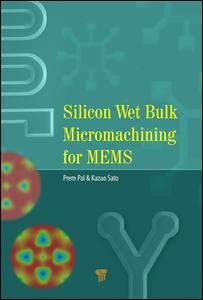Description
Silicon Wet Bulk Micromachining for MEMS
Coordinators: Pal Prem, Sato Kazuo
Language: English
Subjects for Silicon Wet Bulk Micromachining for MEMS:
Keywords
Etch Rate; etch; IOP Publishing; rates; Convex Corner; anisotropic; Wet Anisotropic Etching; etching; Anisotropic Etching; wafer; Mask Edge; convex; Electrochemical Etch Stop; corners; Wet Bulk Micromachining; surface; Etched Profiles; mask; Bulk Micromachining; edge; SEM Picture; TMAH Solution; Etching Solution; Isotropic Etching; KOH Solutions; KOH Concentration; Stereographic Projection; Corner Compensation; Mask Layer; Crystallographic Directions; Silicon Etching; Etch Depth; Concave Corner; Thin Film Shape Memory Alloy; Transdermal Drug Delivery
· 15.2x22.9 cm · Hardback
Description
/li>Contents
/li>Biography
/li>
Microelectromechanical systems (MEMS)-based sensors and actuators have become remarkably popular in the past few decades. Rapid advances have taken place in terms of both technologies and techniques of fabrication of MEMS structures. Wet chemical?based silicon bulk micromachining continues to be a widely used technique for the fabrication of microstructures used in MEMS devices. Researchers all over the world have contributed significantly to the advancement of wet chemical?based micromachining, from understanding the etching mechanism to exploring its application to the fabrication of simple to complex MEMS structures. In addition to its various benefits, one of the unique features of wet chemical?based bulk micromachining is the ability to fabricate slanted sidewalls, such as 45° walls as micromirrors, as well as freestanding structures, such as cantilevers and diaphragms. This makes wet bulk micromachining necessary for the fabrication of structures for myriad applications.
This book provides a comprehensive understating of wet bulk micromachining for the fabrication of simple to advanced microstructures for various applications in MEMS. It includes introductory to advanced concepts and covers research on basic and advanced topics on wet chemical?based silicon bulk micromachining. The book thus serves as an introductory textbook for undergraduate- and graduate-level students of physics, chemistry, electrical and electronic engineering, materials science, and engineering, as well as a comprehensive reference for researchers working or aspiring to work in the area of MEMS and for engineers working in microfabrication technology.
A Brief Introduction of the Crystal Structure. Brief Overview of Silicon Wafer Manufacturing and Microfabrication Techniques. Isotropic Etching of Silicon and Related Materials. KOH-Based Anisotropic Etching TMAH-Based Anisotropic Etching. Convex and Concave Corners in Silicon Wet Bulk Micromachining. Alignment of Mask Patterns to Crystallographic Directions. Simple to Complex Structures Using Wet Bulk Micromachining.
Prem Pal is associate professor in the Department of Physics, Indian Institute of Technology (IIT) Hyderabad, India. He obtained his MTech in solid state materials and PhD in MEMS from IIT Delhi, India, in 1999 and 2004, respectively. From July 2005 to June 2006, he was a postdoctoral researcher at Yonsei Microsystems Laboratory, School of Mechanical Engineering, Yonsei University, Seoul, South Korea. Then he worked in the Department of Micro-Nano Systems Engineering, Nagoya University, Japan, as Center of Excellence (COE) scientist from July 2006 to March 2008 and as JSPS fellow from March 2008 to March 2010. Dr. Pal has published more than 50 papers in peer-reviewed international journals and has made outstanding contributions to the area of silicon wet anisotropic etching, especially its application to the fabrication of MEMS components. His research interests include MEMS technology, MEMS-based sensors, silicon micromachining, and thin films for MEMS.
Kazuo Sato is emeritus professor at Nagoya University, Japan, and professor at the Aichi Institute of Technology, Japan, since 2012. He is also the founding chair of the Micro/Nano Science and Technology Division of the Japan Society of Mechanical Engineers. He received his BS from Yokohama National University, Japan, in 1970 and PhD from the University of Tokyo, Japan, in 1982. He worked with Hitachi Ltd. from 1970 to 1994. He was a professor at the Micromachining and MEMS Laboratory, Nagoya University, from 1994 to 2012. Prof. Sato started his MEMS research in 1983 and has published 151 journal papers, 219 conference papers, and 20 books/book chapters on MEMS technologies. His research areas are micro-/nanophysics in anisotropic etching and mechanical properties of single-crystal silicon, as well as applied microsystems such as sensors and actuators.




